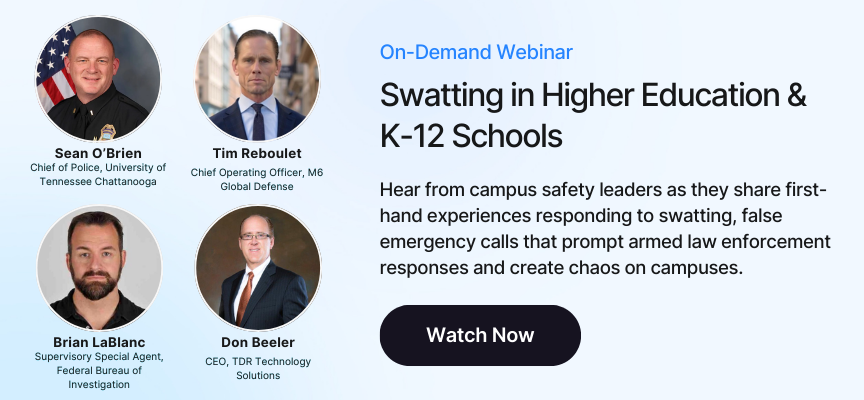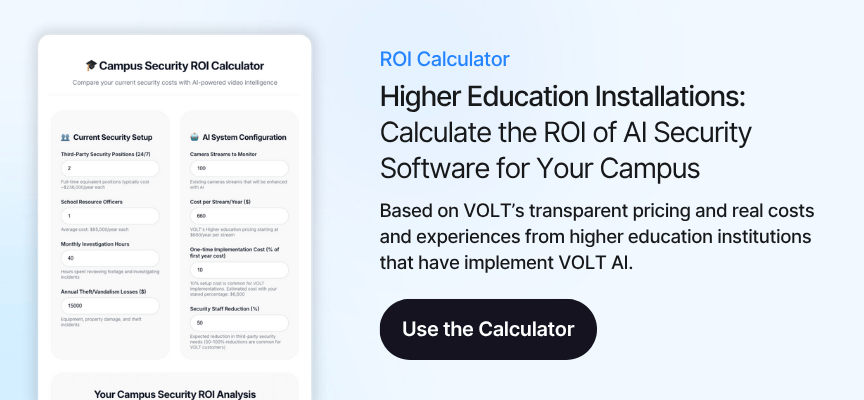Key Points
- K-12 institutions face unique swatting response challenges: Controlled student populations, transportation logistics, and extensive parent communication requirements demand institution-specific protocols during hoax threats
- Higher education campuses require different swatting response approaches: Open campus environments with mobile students demand flexible communication strategies and coordination across multiple jurisdictions
- Dispatcher training prevents costly overreactions: 911 operators trained to recognize swatting indicators can prevent responses that cost institutions hundreds of thousands of dollars per incident
- Information sharing networks save critical resources: Schools establishing communication channels with other institutions can identify repeat swatting threats quickly and make informed response decisions
- AI-powered security technology enhances swatting response: Real-time verification systems help security teams distinguish genuine threats from hoax calls, improving response efficiency
The Growing Swatting Crisis Across Educational Institutions
Swatting incidents have evolved into a significant threat across all educational settings. These hoax threats, designed to trigger massive law enforcement responses, now cost taxpayers over $1 billion annually across K-12 and higher education institutions. During the 2022-2023 school year alone, 63.8% of all violent incidents in schools were false reports of active shooters, demonstrating the scale of this crisis. The perpetrators weaponize technology to create chaos, using spoofed phone numbers and AI-generated sounds to make threats appear credible.
Educational institutions have become prime targets for three distinct reasons. Schools generate high-profile attention that satisfies perpetrators seeking notoriety or entertainment. The environments host concentrated populations that guarantee significant disruption. Most importantly, these institutions operate on carefully planned schedules that make recovery from disruptions particularly difficult.
The swatting response requirements differ dramatically based on institution type. K-12 schools manage populations of minors with limited mobility and extensive parental involvement. Higher education institutions coordinate responses across open campuses with adult students who move freely throughout facilities. Understanding these differences determines whether your swatting response costs $78,000 or $1.4 million.
K-12 Swatting Response Challenges: Managing Controlled Environments
K-12 institutions face distinct operational challenges when responding to swatting incidents. Students remain in controlled environments from the moment school starts until dismissal. Doors lock behind them, creating secure perimeters but also complicating evacuation decisions. Transportation systems add another layer of complexity that higher education never encounters.
The bus system creates unique pressure points during swatting threats. Administrators must decide whether to release students before verifying threat credibility, knowing that buses operate on fixed schedules. A threat received at 5:21 AM forces decisions before buses begin rolling, as one Missouri district discovered during a recent swatting incident. Parents line up immediately after threats, regardless of credibility determinations. One threat that should have cost $78,000 escalated to $1.4 million because unclear communication prompted parents to keep students home for days.
Parent communication in K-12 settings demands more intensive management than higher education. Elementary parents will retrieve children faster than high school parents, but all require timely updates during swatting responses. Schools already communicate frequently about minor achievements, creating notification fatigue. When actual threats occur, critical messages may get lost in the noise.
Districts that establish "one voice" communication policies through partnerships with local law enforcement, prosecutors, and state agencies manage information flow more effectively during swatting incidents.
Higher Education Swatting Response Challenges: Coordinating Open Campus Operations
College and university campuses operate as small cities with fundamentally different security dynamics during swatting responses. Students move constantly between classes, dining facilities, residence halls, and recreational spaces. They carry mobile devices that provide direct communication channels, but also spread unverified information rapidly during swatting incidents.
The University of Tennessee Chattanooga experienced this during their August swatting incident when off-campus individuals posted false information on social media while students sheltered in place.
Campus police departments coordinate with multiple external agencies during swatting responses. A single threat may involve city police, county sheriffs, state patrol, and federal partners depending on jurisdiction boundaries. Chief Sean O'Brien noted the difference in swatting response: "We were able at the command post to slow things down very quickly and just be very methodical."
Communication on college campuses during swatting incidents must balance legal requirements with practical needs. The Clery Act mandates specific notifications for campus threats. Students, faculty, and staff all require updates, but they access information differently than K-12 parents. Higher education institutions that maintain strong relationships with communications directors can push frequent updates during evolving swatting situations, controlling the narrative before social media speculation creates additional panic.
Communication Strategies for Different Educational Settings During Swatting Response
Effective communication during swatting incidents requires strategies tailored to your institution's specific characteristics. K-12 schools manage communication through parents who act as intermediaries with students. Higher education institutions communicate directly with adult students who make their own decisions about safety during swatting threats. Both must establish clear protocols before incidents occur.
Communication Element | K-12 Swatting Response Approach | Higher Education Swatting Response Approach |
Primary Audience | Parents and guardians who control student movement | Students, faculty, and staff who act independently |
Notification Speed | Must reach parents before bus dismissal and during school hours | Continuous updates as students move across campus |
Message Complexity | Simple, action-oriented instructions suitable for forwarding to children | Detailed information allowing adults to assess their own risk |
Legal Requirements | State education codes and district policies | Clery Act mandates and Title IX considerations |
Channel Priority | Text alerts to parent contact lists, robocalls, email | Campus alert apps, email, text, social media monitoring |
Follow-up Cadence | Updates every 15-30 minutes until parent pickup complete | Frequent updates during active response, then all-clear notification |
The one-voice policy proves essential across both environments during swatting responses. This approach designates a single authoritative source for information, typically campus or district leadership working directly with law enforcement. Missouri's K-12 schools established intelligence groups connecting schools, law enforcement, prosecutors, and state agencies for swatting response coordination.
These networks share threat information immediately, allowing schools to recognize patterns and respond appropriately. The University of Tennessee Chattanooga benefited from similar partnerships when their August swatting incident occurred, as Chief O'Brien already had established relationships with all responding agencies.
Timing determines communication effectiveness during swatting threats. The first message sets the tone and triggers either measured responses or panic. Schools that wait to communicate until they have verified information risk social media filling the void with speculation during swatting incidents. Institutions that communicate too quickly with insufficient information may trigger unnecessary evacuations.
The optimal swatting response approach balances speed with accuracy: acknowledge the threat immediately, provide factual updates as verification occurs, and clearly state when normal operations resume.
Building Swatting Response Protocols Based on Institution Type
Swatting response protocols must account for fundamental operational differences between K-12 and higher education. K-12 schools implement lockdown procedures that keep students in classrooms behind locked doors during swatting threats.
Teachers manage small groups in confined spaces while awaiting all-clear notifications. Higher education facilities may shelter hundreds of students in large lecture halls or laboratories during swatting incidents, requiring different management approaches.
The structural and operational differences between institution types directly impact swatting response costs and effectiveness. Understanding these distinctions helps administrators develop appropriate protocols for their specific environment.
Swatting Response Factor | K-12 Institutions | Higher Education Institutions |
Typical Incident Cost | $78,000-$1.4M depending on communication effectiveness | $910,000+ for two-hour response with three-building evacuation |
Critical Decision Timeline | 5:21 AM threat requires decision before buses roll | 12:30 PM threat during class transitions affects thousands simultaneously |
Student Mobility Control | Complete control during swatting response - students cannot leave without adult authorization | Limited control - students move freely and may self-evacuate during threats |
Primary Response Coordination | School district, local PD, potentially county sheriff | Campus PD, city police, county agencies, state patrol, federal partners |
Evacuation Complexity | Bus schedules, parent pickup logistics, minor supervision requirements | Multiple buildings, diverse spaces, adult population making independent decisions |
Communication Cascade Effect | Parents pull siblings from other schools, district-wide impact | Information spreads to other campuses, regional consortium activation |
Recovery Time | Often full day lost due to transportation disruption | Building-by-building clearance allows partial operations within hours |
The 911 dispatch center often determines whether a swatting threat costs thousands or millions of dollars. Dispatchers trained to understand swatting characteristics can prevent massive overreactions. FBI training programs teach dispatchers to recognize key indicators: single calls to non-emergency lines, vague descriptions without verifiable details, AI-generated background sounds.
Schools that coordinate with their dispatch centers to ensure operators receive this training see dramatically improved swatting response outcomes. One Vermont university saved over $1 million when dispatchers recognized a threat matching patterns from earlier incidents.
K-12 districts should develop decision trees for swatting response that account for transportation schedules:
- Before bus departure: Evaluate threat credibility with law enforcement before committing to student transportation
- During school hours: Implement shelter-in-place while verification occurs, avoiding premature evacuation
- During dismissal window: Coordinate with law enforcement to establish safe evacuation routes if evacuation becomes necessary
- After credibility determination: Release students through normal channels if threat deemed non-credible, or implement parent pickup protocols if extended response required
Higher education institutions require more flexible swatting response protocols:
- Initial notification: Push emergency alert to all mobile devices within seconds of threat report
- Area containment: Direct students to shelter in nearest secure location rather than attempting campus-wide lockdown
- Continuous updates: Provide location-specific information as response teams clear buildings
- Graduated release: Allow building-by-building release as areas are verified secure rather than waiting for campus-wide all-clear
Technology Integration for Enhanced Situational Awareness During Swatting Response
AI-powered security systems provide verification capabilities that help both K-12 and higher education institutions make informed decisions during swatting threats. These technologies analyze video feeds in real-time, detecting actual weapons or suspicious behavior while filtering out false alarms.
Chief O'Brien highlighted this during the UTC swatting incident: "Most people didn't know this, but we have AI technology on our cameras in the area where this supposedly was occurring. And I knew right away that we weren't getting any alerts until officers showed up."
Video intelligence platforms like VOLT AI transform existing camera infrastructure into active monitoring systems for swatting response. The technology tracks individuals across facilities using 3D mapping capabilities, maintaining awareness even when weapons become concealed.
This continuous tracking proved valuable at Aspen Academy, where alerts arrived "before the individual with the weapon even got to the entrance of the school." The system provides security teams with crucial context about threat location and movement patterns during swatting incidents.
K-12 schools benefit from technology that integrates with their controlled environment approach to swatting response. Systems that map facility layouts and track movement patterns help administrators understand exactly which classrooms might be affected by threats. Weapon detection capabilities provide immediate verification, allowing schools to maintain normal operations when swatting threats prove false. Schools implementing these systems report response time improvements from minutes to seconds.
Higher education institutions leverage technology differently due to their open campus nature during swatting responses. Systems that monitor multiple buildings simultaneously provide comprehensive coverage across vast areas.
The University of Illinois Chicago deployed VOLT across 142 camera streams on their 250-acre campus, enabling security teams to track incidents across disconnected spaces during swatting threats. The technology helps coordinate responses across multiple buildings, maintaining situational awareness as students move throughout campus during incidents.
Learning from Recent Swatting Incidents: Case Study Insights
Real incidents reveal how institution type affects swatting response effectiveness. The University of Tennessee Chattanooga received a swatting threat at 12:30 PM on their open campus during welcome week. The threat claimed a white male with a rifle was near the library, with AI-generated gunshots playing in the background. Officers arrived within one minute and quickly determined the inconsistencies.
The school evacuated three buildings within two hours, limiting the disruption through measured swatting response. The established relationships Chief O'Brien maintained with local agencies enabled rapid coordination. The incident still cost approximately $910,000 in lost instructional time, but could have been much worse without proper preparation.
Compare this with a K-12 bomb threat in Missouri that arrived at 5:21 AM. The district director of safety arrived in four minutes, before law enforcement response, and immediately recognized the swatting threat as non-credible based on specific location claims that proved false.
However, the superintendent deferred to the local police chief who recommended canceling school. The decision came before buses began rolling, so transportation logistics didn't create additional complications. The district canceled an entire school day for a threat that was identified as false within nine minutes of receipt.
The University of Tennessee Knoxville experienced a swatting incident approximately one week after UTC. Because information sharing networks had already identified the threat pattern and script from UTC, UTK made different swatting response decisions. They recognized the identical characteristics, maintained normal operations, and avoided the significant costs UTC had incurred. This demonstrates the value of information sharing networks, where one institution's experience directly benefits others during swatting threats.
Both institution types learn from incidents through after-action reviews. K-12 schools that experience swatting threats without established protocols often develop comprehensive response plans afterward. Higher education institutions frequently update their emergency notification systems based on communication gaps identified during actual swatting incidents. Schools across both sectors that participate in FBI swatting training programs report average resolution time reductions that save taxpayers an estimated $200 million over two years.
Creating Institutional Resilience Through Swatting Response Preparation
Effective swatting response begins long before threats arrive. K-12 districts should establish relationships with local law enforcement, county prosecutors, and state agencies before incidents occur. These partnerships enable rapid information sharing when swatting threats emerge.
Districts that create email distribution lists connecting superintendents across regions can query other schools within minutes: "Are you seeing something similar?" This collective awareness prevents isolated decision-making based on incomplete information during swatting incidents.
Higher education institutions benefit from regional consortiums that already connect campus police departments for swatting response coordination. The DC area Consortium of Colleges and Universities provides a model where 15 institutions share threat intelligence in real-time. Massachusetts has similar networks.
Schools should leverage these existing relationships, adding communication protocols specifically for swatting incidents. Campus police chiefs who maintain personal relationships with peers at other institutions can make phone calls that provide critical context within seconds during swatting threats.
Both institution types should prioritize 911 dispatch center training for swatting response. Schools cannot control external dispatch operations, but they can advocate for training programs and offer to facilitate FBI instruction. Dispatchers who understand swatting characteristics serve as the first line of defense against overreaction.
They can implement tactical pauses, asking critical questions that reveal hoax indicators before triggering massive responses. This single intervention point affects every threat, making dispatcher education among the most cost-effective investments schools can make for swatting response.
Prevention technology provides another layer of institutional resilience against swatting threats. Systems that filter email threats before they reach inboxes eliminate entire categories of swatting attempts. Voice analysis tools that identify spoofed calls to school phone systems prevent threats from creating initial panic.
These prevention approaches cost dramatically less than responding to actual incidents. A comprehensive prevention program might cost $50,000 annually, while a single swatting response can exceed $900,000. The return on investment becomes clear when examining the full cost of disruption.
Testing and exercises reveal gaps in swatting response before actual incidents expose them. K-12 schools should conduct tabletop exercises that specifically address swatting scenarios, including transportation decision points and parent communication challenges.
Higher education institutions benefit from exercises that test cross-department coordination, particularly between campus police, communications teams, and academic affairs during swatting threats. Schools that discover communication failures during exercises can fix them without the pressure of actual threats.
Your institution type determines your specific challenges, but swatting response preparation principles remain consistent. Know your communication partners before you need them. Train the people who will make critical initial decisions. Implement technology that provides verification capabilities.
Practice your response until it becomes second nature. The difference between a measured swatting response and a costly overreaction often comes down to preparation that happened months before the threat arrived. Review this comprehensive swatting response checklist to ensure your institution has addressed all critical preparation elements.







